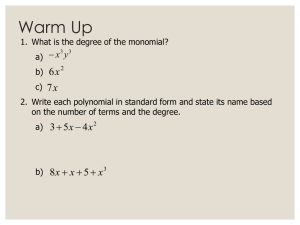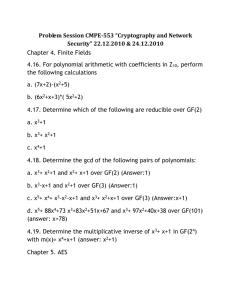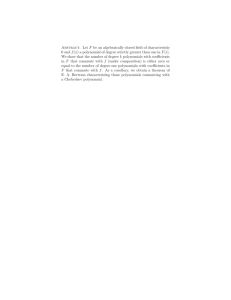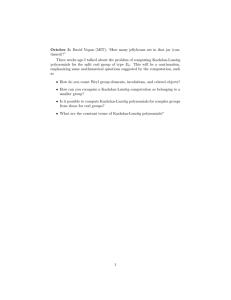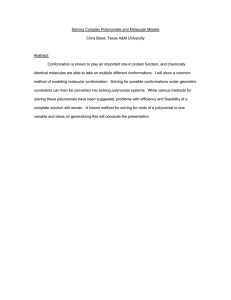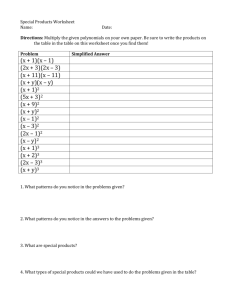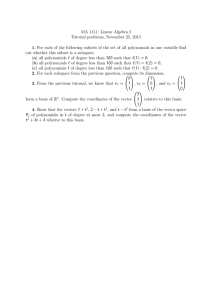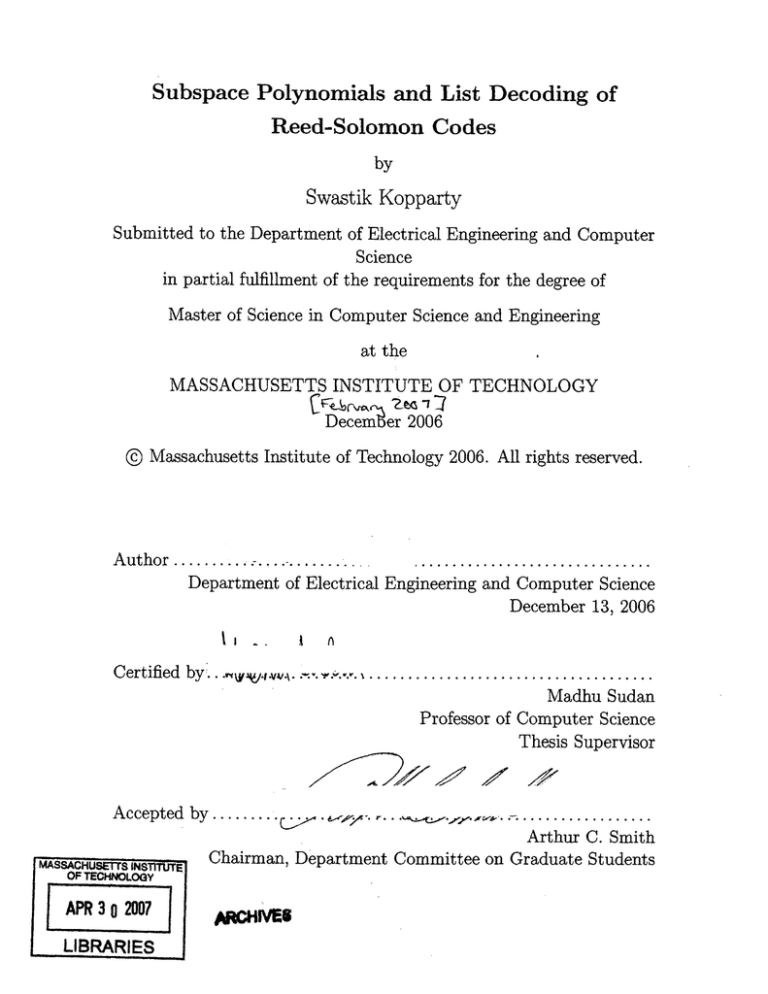
Subspace Polynomials and List Decoding of
Reed-Solomon Codes
by
Swastik Kopparty
Submitted to the Department of Electrical Engineering and Computer
Science
in partial fulfillment of the requirements for the degree of
Master of Science in Computer Science and Engineering
at the
MASSACHUSETTS INSTITUTE OF TECHNOLOGY
DecemCer 2006
© Massachusetts Institute of Technology 2006. All rights reserved.
A uthor ..........
...
......
.
.........
.....................
Department of Electrical Engineering and Computer Science
December 13, 2006
iI
Certified by...
I
A (
-........
....
.......
Madhu Sudan
Professor of Computer Science
Thesis Supervisor
Accepted by .....
.~
............
Arthur C. Smith
MASSACHUSETTS INSTTUTE
OF TECHNOLOGY
APR 3 0 2007
LIBRARIES
Chairman, Department Committee on Graduate Students
P&CHNE6
2
Subspace Polynomials and List Decoding of Reed-Solomon
Codes
by
Swastik Kopparty
Submitted to the Department of Electrical Engineering and Computer Science
on December 13, 2006, in partial fulfillment of the
requirements for the degree of
Master of Science in Computer Science and Engineering
Abstract
We show combinatorial limitations on efficient list decoding of Reed-Solomon codes
beyond the Johnson and Guruswami-Sudan bounds [Joh62, Joh63, GS99].
In particular, we show that for any 6 E (0, 1), there exist arbitrarily large fields
6
FN, IFNI = N, such that for K - N :
]FN that agrees with a
" Existence: there exists a received word WN : FN
super-polynomial number of distinct degree K polynomials oi - N6 points
each;
" Explicit: there exists a polynomial time constructible received word w':
N --+ FN that agrees with a super-polynomial number of distinct degree K
polynomials, on a 2v/log K points each.
In both cases, our results improve upon the previous state of the art, which was
%
N/6 for the existence case [JH01], and a 2N3 for the explicit one [GR,05b].
Furthermore, for 6 close to 1 our bound approaches the Guruswami-Sudan bound
(which is VNK) and rules out the possibility of extending their efficient RS list
decoding algorithm to any significantly larger decoding radius.
Our proof method is surprisingly simple. We work with polynomials that vanish
on subspaces of an extension field viewed as a vector space over the base field. These
subspace polynomials are a subclass of linearized polynomials that were studied by
Ore [Ore33, Ore34] in the 1930s and by coding theorists. For us their main attraction
is their sparsity and abundance of roots.
We also complement our negative results by giving a list decoding algorithm for
linearized polynomials beyond the Johnson-Guruswami-Sudan bounds.
Thesis Supervisor: Madhu Sudan
Title: Professor of Computer Science
3
4
Acknowledgments
I am grateful to Madhu, my advisor, for advice, support, perspective and for many
explanations and discussions on research matters. The results in this thesis are joint
with Eli Ben-Sasson and Jaikumar Radhakrishnan. Many thanks to Eli and Jaikumar
for the constant encouragement.
Swastik Kopparty
Fall 2006
5
6
Contents
1
Introduction
9
1.1
Error-correcting codes and Combinatorial list decoding . . . . . . . .
9
1.2
Reed-Solomon codes
. . . . . . . . . . . . . . . . . . . . . . . . . . .
11
1.3
Overview of our technique: viva subspace polynomials . . . . . . . . .
13
2 The main result and its corollaries
15
2.1
Low rate . . . . . . . . . . . . . . . . . . . . . . . . . . . . . . . . . .
15
2.2
Constant rate . . . . . . . . . . . . . . . . . . . . . . . . . . . . . . .
16
2.3
Explicit constructions . . . . . . . . . . . . . . . . . . . . . . . . . . .
18
2.4
Other Related Work
. . . . . . . . . . . . . . . . . . . . . . . . . . .
18
21
3 Proof of the main result
21
3.1
The construction .............
3.2
List decoding linearized polynomials beyond the Guruswami-Sudan
bound
3.3
. . . . . . . . . . . . . . . . .
Open problems
. . . . . . . . . . . .
7
24
27
S
Chapter 1
Introduction
1.1
Error-correcting codes and Combinatorial list
decoding
An crror-correctingcode is a combinatorial object designed to enable reliable transmission of information on a noisy channel. A fundamental task associated with the
use of error-correcting codes is decoding, that is, recovering the original codeword w,
from the corrupted received word w'.
In list decoding, introduced independently by
Elias [Eli57 and Wozencraft [Woz58], we consider a relaxation of the above task. We
no longer demand that the codeword w be recovered uniquely. Instead, we ask for a
list of possible codewords, and we call the recovery successful if w appears in this list.
The crucial point is that list decoding (with relatively small lists) is possible even
when the received word's agreement with the original word is so small that any hope
of recovering the original word uniquely is unrealistic.
Clearly, the size of the list is a crucial parameter of the problem (to wit, the set
of all codewords is a trivial solution for unbounded list size). In order to quantify the
number of errors one can tolerate for list decoding and appreciate the difference with
unique decoding, let us consider a code with block length N and distance d. Suppose
the number of errors in the transmission is guaranteed to be at most e. Then, in
the worst case, we can uniquely recover the original message only if e is at most 1.
9
Thus, even if d is very close to N, we require that the two words agree on at least
N - !-1 ;>
N
places. With list decoding we can, in principle, tolerate substantially
more errors.
Theorem 1.1.1 (Johnson bound [Joh62, Joh63, GSO1]). Let C be a code with block
length N and distance d. Then, the number of codewords that agree with any word w'
on more than VN(N - d) places is O(N 2 ).
For example, if the code has distance 0.99N, then there are only a polynomial
number of words that agree with the given word on more than (10 places, that is, we
have polynomial size lists as long as the error is less than 0.9N. In fact, a more precise
form of the Johnson bound [GS01] implies that if the error is less than 0.8N, then
there are only a constant number of such codewords. In contrast, unique decoding is
feasible only when the error is guaranteed to be less than 0.495N.
Given a specific family of codes (in this paper, we shall consider Reed-Solomon
codes), we recall two fundamental problems associated with list decoding:
" Combinatorial list decoding: Given code C of block-length N and agreement parameter A < N, estimate the maximal number of distinct codewords
that agree with w' on at least A entries, where the maximum is taken over all
(possibly corrupted) received words w'.
" Algorithmic list decoding: Devise an efficient algorithm for C that on input
w' and agreement parameter A, lists all words that agree with w' on at least A
entries.
In order to solve the algorithmic list decoding problem (for a specific code C and
agreement parameter A) in worst-case time T, at the very least we should have a
combinatorial guarantee that there are no more than T codewords in the list. In
other words, lower bounds for the combinatorial problem imply lower bounds for the
algorithmic one.
Our main result (Theorem 2.0.1) is an improved lower bound for the combinatorial
list decoding problem for Reed-Solomon codes (described next). This result implies
10
super-polynomial lower bounds on the running time of any list decoding algorithm
for Reed-Solomon codes for a sufficiently small agreement parameter.
1.2
Reed-Solomon codes
Reed-Solomon codes, named after their inventors [RS60], are an extensively studied
family of error correcting codes, heavily used in theoretical and practical settings.
The codewords of the Reed-Solomon (RS) code over a field F are the evaluations of
low degree polynomials at N distinct field elements. Bounding the degree of polynomials by K yields a [N, K + 1, N - K]F code, i.e. a linear code over alphabet
F with block-length N, dimension K + 1 and distance N - K. The optimality of
the RS codes (in terms of dimension to distance tradeoff) and their many algebraic
properties contributed to the usefulness and ubiquity of RS codes in coding theory
and theoretical computer science. In what follows we will restrict our attention to
RS codes evaluated over the whole field of size N (i.e. F = FN). Thus, in the space
of all possible received words {w : FN
-+
FN},
the RS code we consider is the subset
RS[N, K] := {(P(a) : O E FN) : P is a polynomial with deg(P) 5 K}.
In this context, the pair of fundamental problems mentioned above boil down to:
* Combinatorial RS list decoding: Given field FN, degree K and agreement
parameter A < N, bound the maximum, over all w : FN
-+
FN,
of the number
of polynomials P E RS[N, K] with agree(w, P) > A, where agree(f, g) := {x E
lFN
:fW =f9(X
* Algorithmic RS list decoding: Given FN, K, A and received word w as
above, efficiently produce the list {P E RS[N, K] : agree(P,w) > A}.
Following a breakthrough by Sudan [Sud97], Guruswami and Sudan [GS99] presented a polynomial time algorithm for solving the algorithmic RS list decoding
problem for agreement parameter A >
/KN.
The Guruswamni-Sudan algorithm
has found spectacular applications not only to coding theory, but also to complexity
11
theory and derandomization (see the surveys [GSO2, Gur06] and pointers therein).
Interestingly, the minimal agreement needed for the Guruswami-Sudan list decoder
to succeed coincides with the Johnson bound stated above. Following the list decoding algorithm of Guruswami-Sudan for Reed-Solomon codes, list decoding algorithms
for several other codes have been discovered. Recent breakthroughs of Parvaresh &
Vardy [PV05] and Gurswami & Rudra [GR05b] have lead to the design of codes (related to Reed-Solomon codes) where efficient list decoding is possible well beyond the
Johnson bound. For Reed-Solomon codes itself, however, the Guruswami-Sudan decoder still provides the best bounds. Since the recent revolution in the understanding
of list decoding started with Reed-Solomon codes, and subsequent developments have
rested on it, and given the ubiquity of RS codes in theory and practice, one would like
to obtain a precise understanding of their list decoding properties. In particular, we
would like to know how big we can allow the radius of the ball to be (or how small the
agreement can be) and still guarantee polynomially many codewords in it. Additionally, lower bounds for list decoding, especially when the received "bad" word w (that
agrees with many RS-codewords) can be produced in polynomial time in N, have
applications for hardness of approximating the minimum distance of a linear code
[DMS99] and constructing error-correcting codes with improved parameters [XinO3].
Prior to this work, there have been several attempts to show combinatorial lower
bounds on the agreement parameter for efficient list decoding.
However, despite
progress on related combinatorial problems (such as RS list recovery [GR05b] and
RS list hitting [CW04], see Section 2.4), the state of the art regarding the combinatorial RS list, decoding problem was rather weak. Apart from the trivial observation
that list decoding to K agreements could produce superpolynomial size lists, the
only bound followed from a relatively straightforward combinatorial argument due
to Justesen & Hoholdt [JHO1] showing (only) for low rates K = N6 (0 < 6 < 1)
that super-polynomially many words agree with some received word on ~ N6 /6 entries. In this paper, we significantly improve on this state of affairs and show that
super-polynomial list size can be obtained for much higher agreement, that at certain
parameters even approaches the Johnson bound. Before describing our results, we
12
present a reformulation of the original argument and motivate the use of subspace
polynomials in improving it.
1.3
Overview of our technique: viva subspace polynomials
Let us start by sketching an argument that shows that for K = N 6 (0 < 6 < 1),
at least
}NW
agreements are required for efficient list decoding. Consider all monic
univariate polynomials in X of degree T that have exactly T roots in FN. There are
exactly
(N)
polynomials. Of these, at least
(N)NT-K-i
have the same coefficients for
monomials of degree greater than K. Construct the received word w by evaluating
one of these polynomials P* at all points in FN. Now if P' is another such polynomial,
then P* - P', a polynomial of degree at most K, agrees with w on T places (because
P* - (P*- P')
(N)N--(T-K--
P' has T roots). Thus, in order to have polynomial size lists,
6
must be bounded by a polynomial. This implies that T > !N .
Let us abstract out what was important in the above argument: a large set of
polynomials with many roots that agree on their top coefficients. The key idea in
our construction is to start with sparse polynomials. The reason this helps is that
we lose fewer polynomials when we try to get their top coefficients to agree. So
are there sparse polynomials of small degree that have many roots? This is where
subspace polynomials come in. Let us briefly describe what they are. Fix a base
field Fq and view its extentsion K = Fqr as a vector space over Fq. Let L be a
T element subspace of this vector space. The subspace polynomial associated with
L is PL(X) =
7JfL
(X - a). It turns out that such polynomials are sparse: only
mnonomials of the form Xq have non-zero coefficients. Thus, a fraction Nof them have the same top coefficients. This is much less than the factor
loq(T/K)
N-(T-K-1)
that we had in the previous argument, however since we require that the roots form
a subspace, we do not start with
(N) polynomials
but only as many as there are T
element subspaces of K. However, as we will see, the tradeoff between these numbers
13
is favorable, and we do obtain a better bound overall.
Subspace polynomials are a special class of linearized polynomials. These are
polynomials that represent Fq-linear functions from K to K, and they are also sparse in
exactly the same way as subspace polynomials. These polynomials were first studied
by Ore [Ore33, Ore34 and have important uses in the study of finite fields and
applications (see Berlekamp [Ber68] and Lidl and Niederreiter [LN97, Chapter 3,
Section 4]). Subspace polynomials recently made their first appearance (to the best
of our knowledge) in the context of computational complexity in the construction of
short PCPs and their related locally testable codes due to Ben-Sasson, Goldreich,
Harsha, Sudan and Vadhan [BSGH+04]. They also play (several different) pivotal
roles in the short PCPs of [BSS05] and in sub-linear proof verification of [BSGH+05].
The properties of subspace polynomials we exploit here are similar to those exploited
by the aforementioned works (but the context is completely different)--- their sparsity,
their many roots and the fact that they represent linear transformations over a vector
space.
Organization
In the Chapter 2 we state the main result and discuss its corollaries.
Chapter 3 contains a proof of the main theorem. In section 3.2 we give a list decoding
algorithm for linearized polynomials. We conclude with some open problems.
14
Chapter 2
The main result and its corollaries
We construct a large family of words from RS[N, K] that reside in a ball of small
radius. We will work in the field
Fqm,
that is N = qm . K will be of the form qU for
integer u (0 < u < m). We start by stating our result in its general form. Later, we
specialize this general result and compare it with the previous state of the art.
Theorem 2.0.1 (Main Theorem). Let q be a prime power and Tn a positive integer.
Let u and v be integers such that 0 < u < v K m. Then, there is a family P C
of polynomials of degree qU and a word w :
1.
LPI
q(u+1)m-v
Fq
-
Fn
r
such
Fqm
X]
that
2
2. for all P c P, agree(w, P)
qv,;
3. there exist scalars au+1, au+2, ...
,nv-1
E Fq. such that for all x E
Fqn,,
v-1
w(x) = x"" + E
aixq.
i=u+1
By choosing q, m, u and v appropriately we can obtain several interesting corollaries of this construction; we describe these corollaries below.
2.1
Low rate
As stated above, Justesen and Hoholdt [JHO1] obtained their lower bound for the
case, K = N6 (0 < 6 < 1). Using our main theorem we can show super-polynomial
15
number of codewords even with substantially larger agreement.
Corollary 2.1.1 (Low rate). Let 6, p E (0, 1) be rational numbers such that 6 < p.
Then, for infinitely many N, there is a word w : FN
{P E RS[N, N6 ] : agree(w, P)
-* FN,
NP} I
such that
2
N(-P~
)o2
N
Proof. Let q = 2 and let m be large enough such that u = 6m and v = pm are
integers. Our claim follows immediately from Theorem 2.0.1.
Comparison to earlier results:
0
(See Figure 2-1) The previous state of the art
for K =ANT, was that there are super-polynomially many codewords if the agreement
required is 1
[JH01] (see [CWO4] for a related argument). For instance, for 6 = '
this quantity is 2v/N. Corollary 2.1.1 improves the super-polynomial lower bound on
list size for agreement as large as Nv--' for any c > 0. (Note, however, that the the
previous arguments gave lists of size 2N"1, whereas our result only promises lists of
size
2 0(lo
2
N).)
As for upper bounds, the Johnson bound says that with agreement
greater than N(1+)/
2
we obtain only polynomially large lists. Once again, for 6 = 12'
the Johnson bound limits the number of codewords at agreement parameter NO7 5 ,
whereas Corollary 2.1.1 states that reducing the agreement to No-7 results in lists of
N(log N)
siz
Notice that when 6 is close to 1, say 6 = 1 - -y (for some small constant 7),
then the Johnson bound ensures that there are only O(N 2 ) words if we require an
agreement nore than N
1, whereas Corollary 2.1.1 shows that there are super-
1
polynomially many words if we relax the requirement to only N i-
(1
-
2.2
-
)2 <:1
-
, for
, (because
<2)
Constant rate
Corollary 2.2.1 (Constant rate). Let r' and r be positive integers such that r' <
r < 2r'. Let R = 2-' and R' = 2-'. Then, for infinitely many N, there is a word
16
w : FN
-
FN,
such that
{P E RS[N, RN] : agree(w, P) > NR'}
> N 2 r'--
Proof. This time we apply Theorem 2.0.1 with q = 2, m large, u = m - r and
E
v = m - r'.
Comparison to earlier results:
No non-trivial bounds were known for the case
of high rate. In particular, the counting arguments used for the case of low rate do
not say anything significant. [As before, there are at least
(')/NT-K
codewords from
RS[N, K that all agree with some word on T places. However, if we choose K = RN
for some constant R, then in order to make
restrict T to be K + 0(N)
(N) /NTK
superpolynomial, we need to
RN(1 + o(1))].
As for the upper bounds for rate R, the Johnson bound shows that the list size is
O(N 2 ) when the agreement is > V RN. In contrast, Corollary 2.2.1 states that if the
radius is decreased to say R+EN (this corresponds to choosing r' = (. + e) r) then
the list size cannot be bounded by a fixed polynomial independent of R: it must be
at least N'
log(R.
For the sake of completeness and due to the importance of algorithmic RS list
decoding, we explicitly state the following limitation to it. Recall that the GuruswamiSudan algorithm finds a list of all codewords with agreement at least (NK) 2 with the
received word. On the other hand it was known that list-decoding to agreement K
could encounter superpolynomial sized lists. The following statement says that one
cannot get a significantly better list decoding algorithm that works in as general as
setting as the Guruswami-Sudan algorithm.
Corollary 2.2.2 (Limits of RS algorithmic list decoding). For all c > 0, there is
no polynomial time algorithm that, for any N, K and received word w : FN produces a list of all P E RS[N, K] with agree(w, P) >
Remark:
K2
FN,
N-
Note however that the corollary produces counterexamples for very low
rates only. It may still be the case that for high rates one can list-decode to large
radii.
17
2.3
Explicit constructions
The lower bounds stated above imply the existence of a word w in large agreement
with many RS-codewords. However, we do not claim w can be constructed in polynomial time in N (inspection of Part 3 of Theorem 2.0.1 reveals it can be computed in
quasi-polynomial time). Restricting our attention to efficient and explicit constructions, we obtain the following.
Corollary 2.3.1 (Explicit construction). Let 6 E (0, 1). Let t and N be such that 6t
is an integer and q = Nt is a prime power. Then, over the field FN, we hae
{P E RS[N, N6 ] : agree(w, P) > qN 6}
where w(x) = xq"
> q(t)(t-6-,1)
for x E FN-
Proof. We apply Theorem 2.0.1 with q = Nt, u = 6t and v = 6t +1.
V
Note that since
u + 1, the polynomial P*(X) = Xqv can be computed explicitly, as claimed.
Comparison to earlier results:
I
The previous state of the art, due to the recent
result of Guruswami and Rudra [GR05b], constructed an explicit word w with
2 N ")
many codewords with agreement (2 - e)N with w. For appropriate choice of paraneters, Corollary 2.3.1 can (for example) give an explicit w with Nn(log
having agreement
2 /log
N)
codewords
NNj. Thus, the agreement in our result is significantly larger
than that of [GR05b], yet the number of codewords is significantly smaller. We stress
that although we do get a super-polynomial number of codewords, for application to
[DMS99] one needs
2.4
2 NnGl)
codewords with much larger agreement.
Other Related Work
There are a few results about problems related to the combinatorial RS list decoding
problem, that we now describe.
Guruswami and Rudra [GR05b] prove that the
Guruswami-Sudan list decoding algorithm is optimal for a more general problem
called Polynomial-Reconstruction and a related problem called List-Recovering of
18
Reed-Solomon codes. Cheng and Wan [CW04] prove that if there is a polynomial
time algorithm for list decoding of Reed-Solomon codes up to some radius, then
certain cryptographic assumptions would be false. The results in this paper make
this statement vacuous over any fields where our constructions apply.
Kiayias and
Yung [KY02] and others have based cryptographic schemes on the hardness of list
decoding Reed-Solomon codes. Our work proves results in the direction of validating
their assumptions.
19
I
Easy [GS98]
0.6 ------
6 0.46
--------0 .7- ------
- --
bO0.4
- --
- - - - ----
----------- --------, - *
-
- --
-
-- -
---------
-- ------ --------- - - ----
-
0 .3 -- -4e-
0
--. 2--------0 .3 ---- --- ---
l 0.1
0.2 0
0.1
------------L
- ---------- ---- - - -N- w--- ----
-O
--- ---.
-------
- --- -- -- --- --- --------
--
-
.
New
....
...........
Johnson-Guruswami-Sudan
0
0.1
0.2
0.3
0.4
0.5
0.6
0.7
0.8
0.9
1
6 = log K/log N
Figure 2-1: A comparison on double logarithmic scale, at N -* oo, of the new bound
(solid red line) with the Johnson-Guruswami-Sudan upper bound (dotted blue) and
the previous Justesen-Hoholdt lower bound (dashed green). The region where efficient
list decoding algorithms exist is marked Easy and where efficient list decoding is
provably infeasible is marked Hard. The status of the unmarked region (between the
solid and dotted lines) is still to be resolved.
20
Chapter 3
Proof of the main result
3.1
The construction
We wish to show that there is a small ball that contains many codewords. We do this
in two steps. First (Proposition 3.1.4), we relate the existence of a small ball with
many codewords to the existence of a large family of polynomials with coefficients
satisfying certain properties. Then (Lemma 3.1.5), by defining a suitable family of
polynomials and using a counting argument, we show that the required large family
of polynomials does exist.
As explained in the introduction, the key idea of our construction is the use of
sparse polynomials that have many roots. Specifically, we work with polynomials
whose roots form subspaces in a field. In this section, we define these polynomials
formally and state the property that we need in our construction.
We view K =
Fqm
as a vector space of dimension m over the base field Fq. In the
proof of Corollary 2.1.1, we take q to be 2; however, in order to obtain good explicit
constructions in Corollary 2.3.1, we need to let q grow with N.
Definition 3.1.1 (Subspace polynomials). Let L be a subspace of K viewed as a
vector space over Fq. The subspace polynomial for L is defined by
PL(X) =fJ(X -).
tEL
21
We think of PL as a function from K to K, and for a set S C K, use PL(S) to
denote the image of S under PL, that is, PL(S) = {PL(s) : s E: S}. The following
proposition appears as [Ber68, Theorem 11.31] (see also [BSGH+04, Claim 8.15]). We
include a proof for the sake of completeness.
Proposition 3.1.2. Let L be a subspace of K. Then, PL has the form
dim L--1
Xeq'm
+
1
a
X*,
i=O
where aj E K.
Proof. Let d = dim L, and consider the d + 1 Fq-linear functions from K to K defined
by f,(x)
=
XqI
for i
=
0,1,..., d. The set of all F-linear functions from L to K
form a K-vector space of dimension d. So, these d + 1 linear functions must have a
non-trivial dependency (when viewed as functions from L to K), that is, there exist
scalars a0 , al ...
, ad
E K (not all zero) such that
E=
0 aOf(x)
=
0 for all x E L.
Thus, there is a non-zero polynomial of the form E aXq' in K[X] of degree at most
qd that vanishes on L. We may assume that this polynomial is monic. But since L
has qd elements there is only one such polynomial (and its degree must be qd), so it
must be PL(X).
0
Definition 3.1.3. A family of polynomials P C K[X] is said to be an (a, k)-family if
1. each polynomial in P has at least 'a' roots in K, and
2. there is a polynomial P*such that for all P E P, P*- P has degree at most k.
We refer to the P* as a pivot for the family.
In the next proposition, we implement the first step of our plan: relate the existence of a ball with many codewords to the existence of a large (a, k)-family.
Proposition 3.1.4. Let a, k and r be positive integers. Then, the following are
equivalent.
(a) There is a word w : K -> K and r polynomials P1 , P 2 ,..., FP of degree at most
k such that for i = 1, 2,
,e,e..
agree(w, P) > a.
22
(b) There is an (a, k)-family of polynomials of size r whose pivot is the unique
polynomial P, of degree at most qm-1 that agrees with the word w on all points
in K.
Proof First, we show that (a) implies (b). Assume (a) holds. Observe that P agrees
with w at the point x if and only if x is a root of the polynomial P"- P. The required
(a, k) family is then {P, - Pi}r_.
Next, we show that (b) implies (a). Assume (b) holds, and fix an (a, k)-family
FN by w(x) = Q*(x). Now, for
Qr} with pivot Q*. Define w : FN
i = 1, 2,..., r, let P = Q* - Qi. Note that w(x) and P agree on x if and only if x
{QI, Q2,
.,
is root of
Q* -
Pi =
Qi.
Since
Qi has
at least a roots, w and P, agree on at least a
points. Also, each P is a polynomial of degree at most k. Thus (a) holds.
0
In the light of the above, in order to establish Theorem 2.0.1, it is enough to
exhibit a large (qU, qv)-faiily of polynomials whenever u < v. We are now ready for
the second step of our plan: exhibit such a family of large size. We need polynomials
with many roots, say at least qv.
Also we need these polynomials to agree on all
their coefficients for monomials of degrees more than qu. We will concentrate on subspace polynomials corresponding to subspaces of dimension approximately v. These
polynomials have degree NV and the required N' roots. Furthermore, by Proposition 3.1.2, they are sparse: they have only v - u non-zero coefficients corresponding
to monomials of degree more than qU. By the pigeonhole principle a fraction at least
N-(Vu) of these polynomials have the same top coefficients. Our main theorem will
then follow by just counting the number of subspaces of dimension v. We now present
this argument more formally.
Lemma 3.1.5 (Main lemma). Let u and v be integers such that 0 < u < v < m.
Then, there is a (qu, qv)-family 'P _ K[X] of size at least q(u+1)2nV
2
. Furthermore,
each polynomial in P is a subspace polynomial of degree qV, and the pivot of the family
has the form
v-1
p*(X ) = Xq' + E oriXq.
i=u+1
23
Proof. Consider the subspace polynomials PL(X) where L is a v-dimensional subspace
of K. By Proposition 3.1.2, these polynomials have the form
vXq" + ECXq%
i=O
where ai E K. The number of subspaces of dimension v is
(qm
-
1) (qm
(qv - 1)(qv
-q)
...
q
-
qvi1)
q) ... (qv - qvl)
> qV(M-V)
-
and by the pigeonhole principle, for at least a fraction q-m(v-u-) of these subspaces,
their subspace polynomials have the same ai for i = u + 1, u + 2, . .. , v. Let this set
of at least qv(-v) x q-m(v-u-1)
-
q(u+i)m-v
2
subspaces be L. Then,
P = {PL : L cL}
is the required (qU, qv)-family.
0
Proof of Theorem 2.0.1
L
3.2
We combine Proposition 3.1.4 and Lemma 3.1.5.
List decoding linearized polynomials beyond
the Guruswami-Sudan bound
In this section, we give a list-decoding algorithm that list-decodes linearized polynomials (defined below) beyond the Guruswami-Sudan radius.
This immediately
implies combinatorial upper bounds on the number of linearized polynomials having certain agreement with any given received word. Our arguments in the previous
chapters proceeded by proving lower bounds on the number of linearized polynomials having certain agreement with a particular received word. Thus different methods, i.e., going beyond subspace polynomials, are needed to prove the tightness of
the Johnson-Guruswami-Sudan bound for Reed-Solomon codes. This algorithm also
gives another explicit family of codes (after Parvaresh-Vardy [PV05] and GuruswamiRudra [GR05a]), albeit very low rate, that can be list decoded beyond the Johnson
bound.
24
Definition 3.2.1. Let Fq be a field. An Fq-linearizedpolynomial over Fqn is a polynomial of the form
m-1
E ai Xqi
i=o
where ai C Fqm for each i.
If
f
:
Fqm
Fqn
is an Fq-linearized polynomial, then
f
is Fq-linear as a map
between Fq-vector spaces. In fact, every Fq-linear map from Fqm to
Fqm
is the evalu-
ation of some Fq-linearized polynomial. By Proposition 3.1.2, subspace polynomials
are also linearized polynomials.
We will need the Guruswami Sudan polynomial reconstruction algorithm [GS99].
Theorem 3.2.2. Let F be a finite field. There is an algorithmGS--poly-reconstruct(S,K)
that, given a rnultiset S C F x F and an integer K, finds all polynomials f(X) of
degrec at most K such that:
S
ly=f(x) > V/SIK
(x,y)eS
and runs in time poly(IS|, |FI).
The key idea for list decoding linearized polynomials is to exploit their Fq-linearity.
Suppose we were given a received word r : Fqm - Fqm. Let us first find all linearized
polynomials
f which have
f, for all x E Fqm,
f(1) = a. We know that for any such linearized polynomial
f(x + 1) = f(x) + f(1) = f(x) + a. Motivated by this we form the
following 2 sets of points:
So= {(x, r(x)) : x E Fqm},
S1
=
{(x, r(x + 1) - a) : x E Fqm}.
Now consider any linearized polynomial f(X) with f(1) = a. Let
V= {(x, f(x)) : x E Fqm}
be its graph. We have |V n SoI = agree(f, r). By Fq-linearity, IV n S( = agree(f, r).
Thus, (here So U Si denotes the multiset )
E
1 y=f(x)
(x,y)ESoUSi
25
=
2agree(f, r).
Thus, feeding the multiset So U S1 to the Guruswami-Sudan algorithm, we can
recover all linearized polynomials of degree at most K with f(1) = a as long as
/So U SilK
2agree(f, r), i.e., as long as agree(f, r) ;> fqmK/2 = VNK/2. Now
simply repeat this for all possible values of a. This list decodes linearized polynomials
from an agreement of VNK/2. In comparison, the Guruswami-Sudan algorithm by
itself would have required an agreement of v'NK for list decoding.
This basic idea is generalized in the following algorithm.
ALGORITHM 1 (r: Fqm -+FgEm, K, c)
1. Pick x 1 ,.. .,
c E
Fqm
linearly independent over IFq.
2. For each y = (yi, . .. , y,) E FS., do:
a) E ]Fc, form the set:
(a) For each a = (a1,,
Sa
aixi) +
( x, r(x -
(b) Define S to be the inultiset
UaEs
ayiY
:
xE
]Fm}
Sa.
(c) Run GS - poly - reconstruct(S,K) to get list L.
3. Output L = UyEFcm
4.
Theorem 3.2.3. Let q be a prime power and let N = qm for some m. For any
r : FN
-> FN,
and any K, ALGORITHM 1 (r : FN -- FN, K, c) returns a list of at
most NC+2 polynomials that contains all linearized polynomials f of degree at most K
with agree(f, r) >
1NK/qc. Furthermore, ALGORITHM 1 runs in time O((qN)c),
with Nc calls to the Guruswami-Sudanpolynomial reconstruction algorithm.
Proof Let f be a linearized polynomial of degree at most K with agree(f, r) >
V/NK/qc. Consider the iteration of step 2 of the algorithm with y = (f(x 1 ), f(x 2 ), ...
Then, in step 2(a), for each a, we get
Sa=
xr(x -
aixi) +
26
aif(xi)
:x E em
.
,
f(xc)).
Thus,
S ly=f~xW
S
l r(x-rZ aixi)+Ziaf x)=
x
xEFqrn
(x,y)ESa
1
r(x-EZ aixi)=f(x-EZ axi)
=
agree(f, r)
xEFqm
This implies that for S = the multiset Ua Sa,
=
ly=f
E
5
a
(x,y)ES
1
=f(x)
(x,y)ESa
=
5 agree(f, r) = qcagree(f, r) > v/(qcN)K.
a
(3.1)
When S is fed to the Guruswami-Sudan algorithm in step 2(c), since ISI = qeN and
is of degree K, Theorem 3.2.2 and (3.1) imply that
f will be in the list L,
and hence
in the final output list L, as desired. The bounds on the running time are clear.
Discussion:
f
L
Theorem 3.2.3 shows that ALGORITHM 1 is a polynomial time list
decoding algorithm for linearized polynomials. As a corollary, an upper bound on the
list size is also obtained. Let c > 0 and set c = 2e logq(N/K) in the theorem. For any
r : Fqm
N
-+
(K) 1/2+
Fqm,
the number of linearized polynomials that have agreement at least
with r is at most N 2E logq(N/K)+2.
Comparison with the discussion after
Corollary 2.3.1 shows that both Theorem 3.2.3 and Corollary 2.3.1 are essentially
optimal when K = O(N). Thus, in a certain sense, the list decoding lower bounds of
Chapter 1 are optimal with regard to subspace polynomials, and different techniques
are needed to prove the tightness of the Johnson-Guruswami-Sudan bound for ReedSolomon Codes.
The above algorithm also shows that the (very low rate) subcode of the ReedSolomon code RS[N, K] consisting of linearized polynomials of degree at most K can
be list decoded beyond the Johnson bound. This gives another explicit example of
such codes after Parvaresh-Vardy [PV05] and Guruswami-Rudra [GR05a].
3.3
Open problems
o The proof of Theorem 2.0.1 uses a counting argument to find a set of coefficients that appear in many subspace polynomials. One method for obtaining an
27
explicit version of Corollary 2.1.1 (that is interesting in its own right) would be
by gaining a better understanding of the coefficients of subspace polynomials.
* Recently, better constructions of list decodable codes based on RS codes were
presented by Parvaresh & Vardy [PV05] and by Guruswami & Rudra [GR05a].
Could our techniques be useful in understanding the limitations of these new
codes? In particular, an essential parameter in [PV05, GR05a] is the "folding"
parameter (denoted M in [PV05] and m in [GR05a]) which is the number of
field elements that comprise a single alphabet symbol in their codes. When
m = 1 one obtains standard RS codes, and as m increases so does the efficient
list-decoding radius (and the minimal required agreement decreases). For large
m [GR05a] obtain efficient list decoding (with polynomial size lists) arbitrarily
close to the rate of the code. Thus, we ask whether our techniques could imply
combinatorial lower bounds for folded RS codes with a small number m > 1 of
field elements per alphabet symbol?
28
Bibliography
[Ber68]
Elwyn R. Berlekamp. Algebraic Coding Theory. Mc Graw-Hill, revised
1984 edition, 1968.
[BSGH+04] Eli Ben-Sasson, Oded Goldreich, Prahladh Harsha, Madhu Sudan, and
Salil Vadhan. Robust PCPs of proximity, shorter PCPs and applications
to coding. In ACM, editor, Proceedings of the 36th Annual ACM Symposium on the Theory of Computing: Chicago, Illinois, USA, June 13-15,
2004, pages 1-10, pub-ACM:adr, 2004. pub-ACM.
[BSGH+05
Eli Ben-Sasson, Oded Goldreich, Prahladh Harsha, Madhu Sudan, and
Salil P. Vadhan. Short PCPs verifiable in polylogarithmic time. In IEEE
Conference on Computational Complexity, pages 120-134, 2005.
[BSS05]
Eli Ben-Sasson and Madhu Sudan. Simple PCPs with poly-log rate and
query complexity. In STOC '05: Proceedings of the 37th annual ACM
Symposium on Theory of Computing, pages 266-275, New York, NY,
USA, 2005. ACM Press.
[CW04]
Qi Cheng and Daqing Wan. On the list and bounded distance decodibility
of Reed-Solomon codes. In IEEE, editor, Proceedings: 45th Annual IEEE
Symposium on Foundations of Computer Science: FOCS 2004, 17-19
October, 2004, Rome, Italy, pages 335-341, 2004.
[DMS99]
Ilya Dumer, Daniele Micciancio, and Madhu Sudan. Hardness of Approximating the Minimum Distance of a Linear Code. In IEEE Symposium
on Foundations of Computer Science, pages 475-485, 1999.
29
[Eli57]
Peter Elias. List decoding for noisy channels. Technical report, Research
Laboratory of Electronics, MIT, 1957.
[GR05a]
Venkatesan Guruswami and Atri Rudra. Explicit capacity-achieving listdecodable codes. Electronic Colloquium on Computational Complexity
(ECCC), (133), 2005.
[GR)5b]
Venkatesan Guruswami and Atri Rudra. Limits to list decoding ReedSolomon codes. In STOC '05: Proceedings of the thirty-seventh annual
ACM symposium on Theory of computing, pages 602-609, New York,
NY, USA, 2005. ACM Press.
[GS99]
Venkatesan Guruswami and Madhu Sudan. Improved Decoding of ReedSolomon and Algebraic-Geometric Codes. In IEEE Transactions on Information Theory, volume 45, pages 1757-1767, 1999.
[GS01]
V. Guruswami and M. Sudan. Extensions to the Johnson bound. 2001.
[GS02]
Venkatesan Guruswami and Madhu Sudan. Reflections on Improved Decoding of Reed-Solomon and Algebraic-Geometric Codes, July 26 2002.
[Gur06]
Venkatesan Guruswami. List Decoding in Average-Case Complexity and
Pseudorandomness. Invited mini-survey to appear in ITW 2006, 2006.
[JHOI]
Jorn Justesen and Tom Hoholdt. Bounds on list decoding of MDS codes.
IEEE Trans. Inform. Theory, 47(4):1604-1609, 2001.
[Joh62]
S. M. Johnson. A new upper bound for error-correcting codes. IEEE
Trans. on Information Theory, 8:203-207, 1962.
[Joh63]
S. M. Johnson. Improved asymptotic bounds for error-correcting codes.
IEEE Trans. on Information Theory, 9:198-205, 1963.
[KY02]
Aggelos Kiayias and Moti Yumng.
Cryptographic Hardness Based on
the Decoding of Reed-Solomon Codes.
In Peter Widmayer, Fran-
cisco Triguero Ruiz, Rafael Morales, Matthew Henmiessy, Stephan Ei30
denbenz, and Ricardo Conejo, editors, International Colloquium in Automata, Languages and Programming - ICALP 2002, volume 2380 of
Lecture Notes in Computer Science, pages 232-243. Springer, 2002.
[LN97]
Rudolf Lidl and Harald Niederreiter. Finitefields, volume 20 of Encyclopedia of Mathematics and its Applications. Cambridge University Press,
Cambridge, second edition, 1997. With a foreword by P. M. Cohn.
[Ore33]
0. Ore. On a special class of polynomials. Trans. Amer. Math. Soc.,
35(3):559-584, 1933.
[Ore34]
0. Ore. Contributions to the theory of finite fields. Trans. Amer. Math.
Soc., 36(2):243-274, 1934.
[PVO5]
Farzad Parvaresh and Alexander Vardy. Correcting errors beyond the
guruswami-sudan radius in polynomial time. In FOCS, pages 285--294,
2005.
[RS60]
I. S. Reed and G. Solomon. Polynomial Codes over Certain Finite Fields.
Journal of Society for Industrial and Applied Mathematics, 8:300--304,
1960.
[Sud97]
Madhu Sudan. Decoding of Reed Solomon Codes beyond the ErrorCorrection Bound. Journal of Complexity, 13(1):180-193, 1997.
[Woz58]
J. M. Wozencraft. List decoding. Quarterly progress report, Research
Laboratory of Electronics, MIT, 48:90-95, 1958.
[Xin03]
Chaoping Xing. Nonlinear codes from algebraic curves improving the
Tsfasman-Vladut-Zink bound. IEEE Transactions on Information Theory, 49(7):1653-1657, 2003.
31

